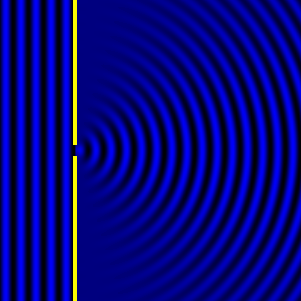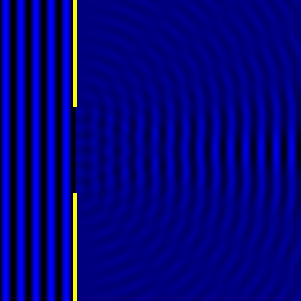Joe McKeown (Talk | contribs) |
Joe McKeown (Talk | contribs) |
||
| Line 95: | Line 95: | ||
</div> | </div> | ||
<p style="font-size: 18px;">The above images (source: Wikipedia - Diffraction Formalism) show examples of patterns being formed in wavefronts by apertures in the path of otherwise uninterrupted waves. As can be seen by contrasting these images, the pattern created by a larger aperture is distinguishable from a smaller aperture's pattern. The particular distinctions can be described through mathematical formalisms. Thence, once the diffraction patterns have been created, it is possible to infer the shape and size of the objects that caused them, if we also know the wavelength of the light source and the distance from the sample at which the patterns were observed. | <p style="font-size: 18px;">The above images (source: Wikipedia - Diffraction Formalism) show examples of patterns being formed in wavefronts by apertures in the path of otherwise uninterrupted waves. As can be seen by contrasting these images, the pattern created by a larger aperture is distinguishable from a smaller aperture's pattern. The particular distinctions can be described through mathematical formalisms. Thence, once the diffraction patterns have been created, it is possible to infer the shape and size of the objects that caused them, if we also know the wavelength of the light source and the distance from the sample at which the patterns were observed. | ||
| − | </p> | + | </p> |
| + | <p style="font-size: 18px;"> | ||
| + | |||
| + | </p> | ||
<br style="line-height: 10px;"> | <br style="line-height: 10px;"> | ||
</div> | </div> | ||
Revision as of 23:09, 3 September 2017
Digital Inline Holographic Microscopy
How does it work?
Digital holographic microscopy makes use of diffraction. This a physical phenomenon wherein objects (or apertures) in the path of a source of waves will create patterns in the waves. These patterns depend on the shape of the objects themselves. Since electromagnetic waves are, somewhat unsurprisingly, waves, it is possible to use the diffraction of light to create patterns that we can see.

- Diffraction pattern caused by a slit of width equivalent to one wavelength.

- Diffraction pattern caused by a slit of width equivalent to six wavelengths.
The above images (source: Wikipedia - Diffraction Formalism) show examples of patterns being formed in wavefronts by apertures in the path of otherwise uninterrupted waves. As can be seen by contrasting these images, the pattern created by a larger aperture is distinguishable from a smaller aperture's pattern. The particular distinctions can be described through mathematical formalisms. Thence, once the diffraction patterns have been created, it is possible to infer the shape and size of the objects that caused them, if we also know the wavelength of the light source and the distance from the sample at which the patterns were observed.
Co-Cultures: Bacteria and Algae can be Friends!
Go Together, Grow Together.
This section is still under development, but it will soon contain information regarding a co-culture comprising Chlamydomonas reinhardtii and Escherichia coli.



